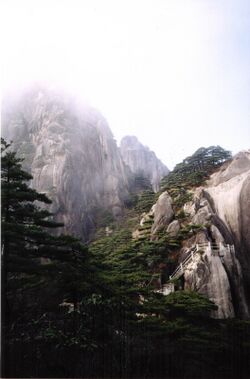Biology:Pinus hwangshanensis
| Huangshan pine | |
|---|---|

| |
| Huangshan pines on the Huangshan Mountains, Anhui | |
| Scientific classification | |
| Kingdom: | Plantae |
| Clade: | Tracheophytes |
| Clade: | Gymnospermae |
| Division: | Pinophyta |
| Class: | Pinopsida |
| Order: | Pinales |
| Family: | Pinaceae |
| Genus: | Pinus |
| Subgenus: | P. subg. Pinus |
| Section: | P. sect. Pinus |
| Subsection: | P. subsect. Pinus |
| Species: | P. hwangshanensis
|
| Binomial name | |
| Pinus hwangshanensis W.Y.Hsia
| |
| Synonyms[2] | |
| |
Pinus hwangshanensis,[1] or Huangshan pine, is a species of pine endemic to the mountains of eastern China; it is named after the Huangshan Mountains in Anhui, from where it was first described.
Description
Pinus hwangshanensis is an evergreen tree reaching 15–25 metres (49–82 feet) in height, with a very broad, flat-topped crown of long, level branches. The bark is thick, grayish, and scaly plated. The leaves are needle-like, dark green, 2 per fascicle, 5–8 centimetres (2–3 1⁄4 inches) long and 0.8–1 millimetre (1⁄32–3⁄64 in) wide, the persistent fascicle sheath 1 cm (1⁄2 in) long. The cones are broad squat ovoid, 4–6.5 cm (1 1⁄2–2 1⁄2 in) long, yellow-brown, opening when mature in late winter to 5–7 cm broad. The seeds are winged, 5–6 mm (3⁄16–1⁄4 in) long with a 1.5–2.5 cm wing. Pollination occurs in mid-spring, with the cones maturing 18–20 months after.[citation needed]
It is closely related to Japanese black pine (P. thunbergii), differing from it in the slenderer leaves, brown (not white) buds and broader cones.[citation needed]
Distribution and habitat
Huangshan pines are endemic to the mountains of eastern China, in the provinces of Anhui, Fujian, Guizhou, Hubei, Hunan, Jiangxi, and Zhejiang.[citation needed]
They typically grow at moderate to high altitudes on steep, rocky crags, and are a major vegetation component in the landscapes of eastern China. Many specimens are venerated for their unique rugged shapes and are frequently portrayed in traditional Chinese paintings.[citation needed]
References
- ↑ 1.0 1.1 Farjon, A. (2013). "Pinus hwangshanensis". IUCN Red List of Threatened Species 2013: e.T42370A2975804. doi:10.2305/IUCN.UK.2013-1.RLTS.T42370A2975804.en. https://www.iucnredlist.org/species/42370/2975804.
- ↑ "The Plant List: A Working List of All Plant Species". http://www.theplantlist.org/tpl/record/kew-2562042.
External links
Wikidata ☰ Q2737852 entry
 |




